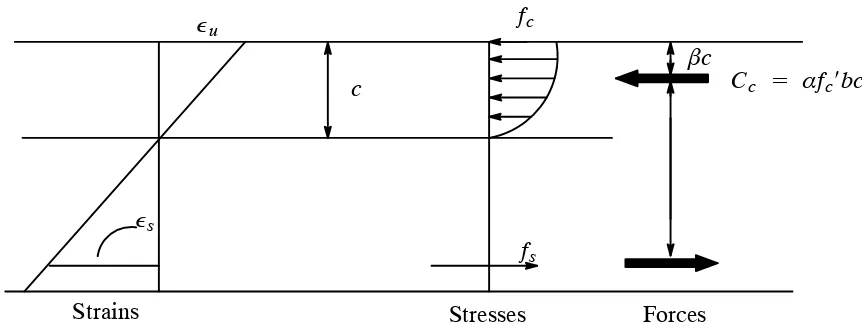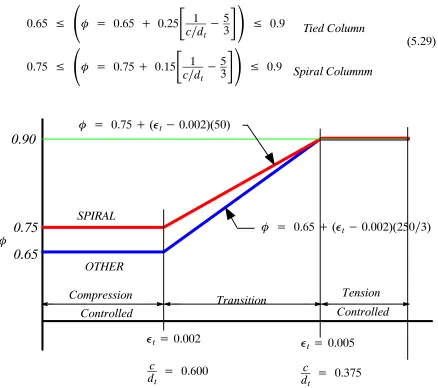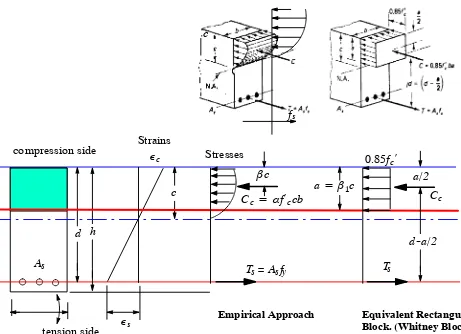5. Flexural Analysis and Design of Beams
5.1. Reading Assignment
Chapter 3 of text
5.2. Introduction
It is of interest in structural practice to calculate those stresses and deformations which occur
in a structure in service under design load. For reinforced concrete beams this can be done by the
methods just presented, which assume elastic behavior of both materials. It is equally, if not more,
important that the structural engineer be able to predict with satisfactory accuracy the ultimate
strength of a structural member. By making this strength larger by an appropriate amount than the
largest loads which can be expected during the lifetime of the structure, an adequate margin of safety
is assured. Until recent times, methods based on elastic analysis like those just presented have been
used for this purpose. It is clear, however, that at or near the ultimate load,stresses are no longer proportional to strains.
At high loads, close to ultimate, the distribution of stresses and strains is that of figure 2 rather
that the elastic distribution of stresses and strains given in figure 1 below. More realistic methods of
analysis, based on actual inelastic rather than an assumed elastic behavior of the materials and results
many experimental research, have been developed to predict the ultimate strength.
Ác fc
Ás
fs
Ás
fs
fc Ác
CIVL 4135 85 Flexure As progressively increasing bending moments are applied to the beam, the strains will increase as
exemplified byε1,ε2, andε3as shown below. Corresponding to these strains and their linear
varia-tion from the neutral axis, the stress distribuvaria-tion will look as shown.
Á2
Á
Á1 Á2 Á3
f1 f2 f3 Stress
Strain Stress
Á1 Á3
f1 f2
Á2
Á
Á1 Á2 Á3
f1 f2 f3 Stress
Strain Stress
Á1 Á3
f1 f2
CI
VL
4135
Flexur
e
87
Cracks, Strains, and Stresses in test beam (From Nawy’s Book).
5.1
5.3. Flexure Strength
As it was mentioned earlier it is important that the structural engineer be able to predict with
satisfactory accuracy the ultimate strength of a structural member. It is important to know that at or
near the ultimate load,stresses are no longer proportional to strains.
Actual inspection of many concrete stress-strain curves which have been published, show
that the geometrical shape of the stress distribution is quite varied and depends on a number of factors
such as cylinder strength, the rate, and duration of loading.
Below is a typical stress distribution at the ultimate load.
Ás
fs
fc Áu
Strains Stresses Forces c
βc
Cc = αfc′bc
Figure 5.2. Strain, Stress, and Force Diagrams
5.4. Two Different Types of Failure
There are two possible ways that a reinforced beam can fail:
• Beam will fail by tension of steel
Moderate amount of reinforcement is used. Steel yields suddenly and stretches a large amount, tension cracks become visible and widen and propagate upward (Ductile Fail-ure)
• Compression failure of concrete
CIVL 4135 89 Flexure In a rectangular beam the area that is in compression isbc, and the total compression force on this
area can be expressed asC=favbc, wherefavis the average compression stress on the areabc.
Evi-dently, the average compression stress that can be developed before failure occurs becomes larger
the higher the cylinder strengthfc’of the particular concrete. Let
α = fav
fc′
then
Cc = favbc = αfc′bc
compression force is applied atβc distance from top fiber, andcis the distance of the N.A. from top fiber.
Based on research we have:
α = 0.72 − fc′ − 4, 000
1000 ×0.04 and 0.56 < α < 0.72
β = 0.425 − fc′ − 4, 000
1000 ×0.025 and 0.324 < β< 0.425
(5.7)
(5.8)
FORCES
From equilibrium we haveCc=Tor
αfc′bc = Asfs (5.9)
M = TZ = Asfs(d − βc) (5.10)
or
5.5. Tension Failure
Substitutecfrom Eq. (5.13) in Eq. (5.10)
Mn = Asfy
d − Ã βαffcy′d
(5.14)with the specific, experimentally obtained values forαandβwe always have
β
α = 0.59 for fc′ = 4, 000psi or any other strength (5.15)
Therefore, Eq. (5.14) simplifies as
Mn = Asfy
d − 0.59ÃwhereMn = nominal moment capacity.
5.6. Compression Failure
In this case, the criterion is that the compression strain in the concrete becomesεu= 0.003, as
previously discussed. The steel stressfs, not having reached the yield point, is proportional to the
steel strain,εs; i.e. according to Hooke’s law:
Áu = 0.003 (ACI 10.2.3), and fs <fy (5.18)
CIVL 4135 91 Flexure from similar triangles we have
Áu
c = d −Ás c → Ás = Áud −c c (5.20)
substitute Eq. (5.20) in Eq. (5.19)
fs = EsÁs = EsÁu d −c c < fy (5.21)
From Eq. (5.9) we have
αfc′bc = Asfs = AsEsÁu d −c c (5.22)
Using Eq. (5.22) solve for c, and then findMn, the nominal moment capacity.
5.7. Balance Steel Ratio
We like to have tension failure, because it gives us warning, versus compression failure
which is sudden. Therefore, we want to keep the amount of steel reinforcement in such manner that
the failure will be of tension type.
Balanced steel ratio,ρbrepresents the amount of reinforcement necessary to make a beam fail by crushing of concrete at the same load that causes the steel to yield. This means that neutral axis
must be located at the load which the steel starts yielding and concrete starts reaching its compressive
strain ofεu = 0.003. (ACI 10.2.3)
cb = Á Áu
y + Áud
(5.23)
T = C → Abs fy = αfc′bcb (5.24)
Abs fy = Ãbbd fy = αfc′b Á Áu u + Áyd
(5.25)
Ãb = α fc′
fy
Áu Áu + Áy
5.8. Strain Limits Method for Analysis and Design (ACI 318).
In “Strain Limits Method,” sometime referred to as the “Unified Method,” the nominal
flex-ural strength of a concrete member is reached when the net compressive strain in the extreme
com-pression fiber reaches the ACI code-assumed limit of 0.003 in/in (ACI 10.2.3). It also hypothesized
that when the net tensile strain in the extreme tension steel,εt= 0.005 in/in, the behavior is fully
duc-tile. The concrete beam sections characterized as “Tension-Controlled,” with ample warning of
fail-ure as denoted by excessive deflection and cracking.
If the net tensile strain in the extreme tension fibers,εt, is small, such as in compression
mem-bers, being equal or less than a “Compression-Controlled” strain limit, a brittle mode of failure is
expected with a sudden and explosive type of failure. Flexural members are usually
tension-con-trolled. However, some sections such as those subjected to small axial loads, but large bending
mo-ments, the net tensile strain, εt, in the extreme tensile fibers, will have an intermediate or transitional
value between the two strain limit states, namely, between the compression-controlled strain limit of
Át =
fy
Es =
60ksi
29, 000ksi=0.002
(5.27)
and the tension-controlled strain limitεt = 0.005 in/in. Figure 5.3 (ACI Figure R9.3.2 page 118)
shows these three zones as well as the variation in the strength reduction factors applicable to the
CIVL 4135 93 Flexure 5.8.1. Variation ofΦas a Function of Strain
Variation of theφvalue for the range of strain betweenεt= 0.002 in/in and εt= 0.005 in/in can
be linearly interpolated:
0.65 ≤ φ = 0.65 + (Át−0.002)(250∕3)) ≤ 0.90
Tied Column
Spiral Columnm 0.75 ≤ (φ = 0.75 + (Át − 0.002)(50)) ≤ 0.90
(5.28)
5.8.2. Variation ofΦas a Function of Neutral Axis Depth Ratio c/d
0.65 ≤
φ = 0.65 + 0.25
1Figure 5.3. Example. Calculate Nominal Moment Capacity of a Beam for Fy = 60 ksi
5.9. Example. Calculate Nominal Moment Capacity of a Beam
fc′ = 4, 000 psi
Determine the nominal momentMn at which the beam given below will fail.
Given
CIVL 4135 95 Flexure 5.10. Prediction of Nominal Strength in Flexure by Equivalent Rectangular Stress Block
• Represents an extension of the empirical method.
• Simpler than empirical method - No secondary calculation necessary to locate centroid (always at stress block center).
• Allows for considerations and analyses of non-rectangular sections.
• Must be developed such that it gives the same answer as empirical method - requires same total compression force and same centroid location.
• Development of the method:
Empirical Approach Equivalent Rectangular Block. (Whitney Block)
Figure 5.4. Equivalent Rectangular Block (From Nawy’s Book).
βc
Require the forces to have the same location:
Cc = αfc′cb = γfc′ab from which γ = αac
For balanced steel ratio we have
T = C
ACI 10.3.5. Maximum Net Tensile Strain
For nonprestressed flexural members and prestressed members with axial load less than
0.10f′cAgthe net tensile strainÁtat nominal strength shall not be less than 0.004.
Ãmax = 0.85β1ffc′
y
Áu
CIVL 4135 97 Flexure
Max Net Tensile Strain
Áu
Max net Tensile Strain
Át=0.004
CIVL 4135 99 Flexure 5.10.1. Example
Consider the same example problem given in Section 5.9.
à = As
bd =
2.35
10×23 = 0.0102
0.85fc′ ab = As fy → a =
(2.35 in2)×(60, 000 psi)
0.85×(4, 000 psi)×(10 in) = 4.15 in
Mn=Asfy(d−a
2)=(2.35 in
2))×(60, 000 psi)×(23−2.07)=246, 000 lb--ft=246 kip--ft = 2, 950, 000 lb−in = 246 k−ft
c = a∕β1 = 4.15∕0.85=4.88
c d =
4.88
23 =0.212<0.375
Tension failure
Therefore the nominal moment capabit will be:
φ=0.9
5.10.2. Example. Calculate Nominal Moment Capacity of a Beam
fc′ = 4, 000 psi
Determine if the beam shown below will fail in tension or compression.
Given
fy = 60, 000 psi
Solution
c = a
β1=10.590.85 = 12.46
21”
10”
18”
As=6.00 in2
c d =
12.46
18 =0.69> 0.6 Compression failure a = As fy
0.85fc′ b
a = 6×60ksi
0.85×4ksi × 10=10.59 in
CIVL 4135 101 Flexure 5.10.3. Example. Calculate Nominal Moment Capacity of a Beam
fc′ = 4, 000 psi
Determine if the beam shown below will fail in tension or compression.
Given
fy = 40, 000 psi
Solution
c = a
β1=7.060.85 = 8.31in
21”
10”
18”
As=6.00 in2
c d =
8.31
18 =0.46>0.428< 0.685 Transition Zone a = As fy
0.85fc′ b
a = 6×40ksi
0.85×4ksi × 10=7.06 in



